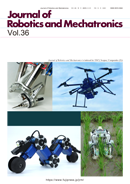最新号
選択された号の論文の23件中1~23を表示しています
- |<
- <
- 1
- >
- >|
Review on Fluid-Driven Soft Actuators for Soft Robots
-
原稿種別: Review
2024 年 36 巻 2 号 p. 251-259
発行日: 2024/04/20
公開日: 2024/04/20
PDF形式でダウンロード (8447K)
Special Issue on Advanced Robotic Technology and System for DX in Construction Industry
-
原稿種別: Editorial
2024 年 36 巻 2 号 p. 261-262
発行日: 2024/04/20
公開日: 2024/04/20
PDF形式でダウンロード (856K) -
原稿種別: Paper
2024 年 36 巻 2 号 p. 263-272
発行日: 2024/04/20
公開日: 2024/04/20
PDF形式でダウンロード (9381K) -
原稿種別: Paper
2024 年 36 巻 2 号 p. 273-283
発行日: 2024/04/20
公開日: 2024/04/20
PDF形式でダウンロード (5116K) -
原稿種別: Paper
2024 年 36 巻 2 号 p. 284-293
発行日: 2024/04/20
公開日: 2024/04/20
PDF形式でダウンロード (5298K) -
Dynamic Visualization of Construction Sites with Machine-Borne Sensors Toward Automated Earth Moving原稿種別: Paper
2024 年 36 巻 2 号 p. 294-308
発行日: 2024/04/20
公開日: 2024/04/20
PDF形式でダウンロード (7654K) -
原稿種別: Paper
2024 年 36 巻 2 号 p. 309-319
発行日: 2024/04/20
公開日: 2024/04/20
PDF形式でダウンロード (4604K) -
原稿種別: Paper
2024 年 36 巻 2 号 p. 320-333
発行日: 2024/04/20
公開日: 2024/04/20
PDF形式でダウンロード (5180K) -
原稿種別: Paper
2024 年 36 巻 2 号 p. 334-342
発行日: 2024/04/20
公開日: 2024/04/20
PDF形式でダウンロード (7697K) -
原稿種別: Paper
2024 年 36 巻 2 号 p. 343-352
発行日: 2024/04/20
公開日: 2024/04/20
PDF形式でダウンロード (3725K) -
原稿種別: Paper
2024 年 36 巻 2 号 p. 353-364
発行日: 2024/04/20
公開日: 2024/04/20
PDF形式でダウンロード (4827K) -
原稿種別: Development Report
2024 年 36 巻 2 号 p. 365-374
発行日: 2024/04/20
公開日: 2024/04/20
PDF形式でダウンロード (3418K)
Regular Papers
-
原稿種別: Paper
2024 年 36 巻 2 号 p. 375-387
発行日: 2024/04/20
公開日: 2024/04/20
PDF形式でダウンロード (3330K) -
原稿種別: Paper
2024 年 36 巻 2 号 p. 388-395
発行日: 2024/04/20
公開日: 2024/04/20
PDF形式でダウンロード (12639K) -
原稿種別: Paper
2024 年 36 巻 2 号 p. 396-405
発行日: 2024/04/20
公開日: 2024/04/20
PDF形式でダウンロード (9395K) -
原稿種別: Paper
2024 年 36 巻 2 号 p. 406-414
発行日: 2024/04/20
公開日: 2024/04/20
PDF形式でダウンロード (8281K) -
原稿種別: Paper
2024 年 36 巻 2 号 p. 415-425
発行日: 2024/04/20
公開日: 2024/04/20
PDF形式でダウンロード (9633K) -
原稿種別: Paper
2024 年 36 巻 2 号 p. 426-437
発行日: 2024/04/20
公開日: 2024/04/20
PDF形式でダウンロード (6283K) -
原稿種別: Paper
2024 年 36 巻 2 号 p. 438-448
発行日: 2024/04/20
公開日: 2024/04/20
PDF形式でダウンロード (3923K) -
Development of Formation Control System for Multiple AUVs with Sonar Interference Avoidance Function原稿種別: Paper
2024 年 36 巻 2 号 p. 449-457
発行日: 2024/04/20
公開日: 2024/04/20
PDF形式でダウンロード (3795K) -
原稿種別: Paper
2024 年 36 巻 2 号 p. 458-471
発行日: 2024/04/20
公開日: 2024/04/20
PDF形式でダウンロード (7232K) -
原稿種別: Paper
2024 年 36 巻 2 号 p. 472-482
発行日: 2024/04/20
公開日: 2024/04/20
PDF形式でダウンロード (11013K) -
原稿種別: Paper
2024 年 36 巻 2 号 p. 483-493
発行日: 2024/04/20
公開日: 2024/04/20
PDF形式でダウンロード (6451K)
- |<
- <
- 1
- >
- >|
